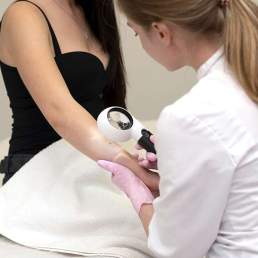Mole Removal in Newcastle
Mole Removal
If you are looking for mole removal then our specialist Dermatologists are able to provide you with sound advice and excellent operating skills.
Most moles don’t require treatment. But you might want to have a mole removed if you’re unhappy with how it looks or feels. Talk with your healthcare provider if you’re concerned about a mole. Generally, moles are removed if your provider suspects they might be cancerous or for cosmetic reasons.

How do dermatologists remove moles?
The Procedure
Surgical excision
Excision is a very common technique for mole removal. After cleaning and numbing the area, your surgeon uses a scalpel to separate your mole from the rest of your skin.
Depending on the type of mole, we’ll take a margin of healthy skin to ensure that all of the atypical cells are removed. Then, using forceps to grasp the segment, lift the mole away. Bleeding is normal, and your dermatologist / surgeon may apply pressure to the area or burn (cauterize) it to stop the bleeding before stitching the area back together.
Shave excision
Another common technique for mole removal is shave excision. Shave excision can provide a sample of tissue for analysis, and people are generally pleased with the results after healing.
For shave excision mole removal, the surgeon will use a single or double-bladed razor to carefully shave the growth off to the level of the skin around it. They may lightly burn (cauterize) the area around the removed mole to improve the appearance of any scar after healing.
Moles removed by shave incision are somewhat more likely to come back than moles removed by surgical excision.

Appointments
What To Expect
When you attend a consultation, the moles will be examined first to ensure they are suitable for a mole removal procedure. You will then be provided with the options available.
Whether you have surgical excision or shaving to remove a mole, the procedure is quick and shouldn’t hurt once the area is numb. After the procedure, you may have stinging or burning around the area for a few days.
Cosmetic Mole Removal
Why choose Eldon?
Whether you were born with a mole or it developed over time, you might not like how it looks or feels. If you have a mole that bothers you, discuss your concerns with your healthcare provider or contact our dermatological team who can guide you through the options.
Don’t attempt at-home mole removal. Getting a mole removed by a medical professional is safer and you’ll be happier with how you look after you heal.

Mole Removal FAQ's
Moles can also be removed for cosmetic reasons. Whether you have surgical excision or shaving to remove a mole, the procedure is quick and shouldn’t hurt once the area is numb. After the procedure, you may have stinging or burning around the area for a few days.
Most moles don’t require treatment. But you might want to have a mole removed if you’re unhappy with how it looks or feels. Talk with your healthcare provider if you’re concerned about a mole. Generally, moles are removed if your provider suspects they might be cancerous or for cosmetic reasons.
There are two main methods of mole removal: surgical excision and shave excision. As with all surgical procedures, there are risks and benefits to both types of mole removal procedures. Talk with your dermatologist about which method is right for you.
Typical moles are round, flat or slightly raised, even in color and stay pretty much the same shape and size over time. But if your mole looks atypical (dysplastic), your healthcare provider might suggest removing it so they can run tests to determine if it’s cancer (malignant) or not cancer (benign).
Moles can become cancerous and, if this condition is not diagnosed quickly, the affected cells can spread to other parts of the body. Mole removal can prevent the spread of cancerous and pre-cancerous cells and address your cosmetic concerns in one simple procedure.
The shave excision works best for a mole that is slightly raised. In this procedure, we go under the mole and the removal leaves a flat white mark and a slight dent in the skin.
Approximately 2–4 weeks after mole removal, as healing tissue begins to build up, the affected area may look rough and red and feel stiff. Although the wound area could be a little raised and red for 1–2 months, the scar typically becomes less red and flatter over time.
Technically, a dermatologist has the skills to perform surgical mole removal with a scalpel. But if you want to keep scarring to a minimum, it would be better to visit a plastic surgeon to get the procedure done. Plastic surgeons specialize in performing deep incisions safely and productively.
Mole Removal in Newcastle
Book your mole removal consultation today
Our talented team of beauty therapists live and breathes customer satisfaction.
Book your mole removal today and come in for an unforgettable experience. We can’t wait to meet you!
